In Section 6 of Executive Order 13780 issued on March 6, 2017, President Donald Trump temporarily suspended the U.S. Refugee Admissions Program (USRAP)—which manages the process of resettling refugees to the U.S.—and reduced the yearly number of resettled refugees from 110,000 to 50,000.[REF] While there are ongoing legal battles over this revised executive order, it provides an opportunity for policymakers to reform parts of USRAP, thereby ensuring that it continues to serve American interests. Inherent in an appropriate USRAP would be the ideas that there is no universal right to migrate, resettlement is not the solution to mass displacement, and U.S. policymakers have a responsibility to advance the national interests of the United States above those of other nations.
USRAP is a useful humanitarian initiative with which the U.S. engages the world and provides relief for a select few during international crises. It supports U.S. interests by enabling the U.S. to assert leadership in foreign crises, assist in the midst of intractable crises, and help allies and partners in need. It also strengthens U.S. public diplomacy and tangibly alleviates human suffering.
To ensure the long-term vitality of USRAP, policymakers should consider a number of policy priorities and reforms. It is critical that the U.S. institute a comprehensive strategy for assimilating refugees, and it should mobilize civil society and enhance existing public-private partnerships, such as the Matching Grant Program, to assist. Improving vetting by developing a person-centric vetting system, focusing on the best candidates for resettlement, and helping U.S. Citizenship and Immigration Services (USCIS) officers who approve refugees’ resettlement applications to build greater expertise in the regions in which they operate would also improve USRAP. As well, the U.S. should commit most of its resources earmarked for refugees to assisting front-line states, where those resources can stretch the furthest to help the largest number of refugees. Finally, the U.S. should affirm the role of both the executive and Congress in establishing refugee admissions levels.
With these reforms, USRAP will serve U.S. interests more strongly.
The Principles Undergirding USRAP Reform
USRAP is a useful humanitarian initiative with which the U.S. engages the world and provides relief for a select few during international crises. Given the current controversy surrounding refugee resettlement, and before examining why USRAP is useful to the U.S., it is worthwhile to articulate some of the principles that should guide policymakers seeking to ensure that USRAP fulfills its proper function.
First, there is no global right to migration. Managing who crosses its borders is central to a state’s sovereignty, and is a duty every country in the world jealously seeks to fulfill. This fact applies to USRAP. The United States operates the program not because it is obligated to resettle refugees, but because the U.S. is a humane country and USRAP serves its national interests.
Second, resettlement is not the solution to mass displacement. Only the resolution of conflict will rectify the associated refugee crises. Resettlement is expensive. Resettling one refugee to the U.S. is about 12 times costlier than providing for that refugee in a camp closer to his home for five years.[REF] Resettlement was also designed as a last resort for only the neediest and most vulnerable refugees. Finally, in 2015 there were 21.3 million refugees worldwide, far beyond the international community’s willingness and ability to resettle responsibly.
Third, U.S. policymakers have a moral and constitutional duty to care for American interests first—above those of non-Americans’ needs. Doing otherwise would be a violation of the trust Americans have placed in them. Because of this, U.S. policymakers have a responsibility to ensure that the United States takes in only as many refugees as it can safely vet and assimilate.
USRAP is a net positive for the country; it advances American interests in five key ways by:
- Enabling the U.S. to assert American leadership in foreign crises. Resettling refugees is one way for the U.S. to exercise global leadership. It demonstrates U.S. engagement to the international community, and enhances the persuasiveness of U.S. appeals to other countries to do more to help ameliorate crises.
- Providing the U.S. with a way to respond positively to intractable crises. There is little the U.S. can reasonably do about some global conflicts, either because they are beyond solving or it is not sufficiently in U.S. interests to expend the resources required to solve them. Resettling refugees is a small but concrete and useful action the U.S. can take in response to otherwise intractable crises.
-
Assisting allies and partners in crisis. Refugee-hosting countries are often fragile, and the challenge of caring for and managing refugees can exacerbate their instability. Some of these countries are also American allies, such as the three currently hosting the most Syrian refugees: Turkey, Lebanon, and Jordan. Jordan has one of the most pro-U.S. governments in the Middle East, and is part of the U.S.-led coalition carrying out air strikes against ISIS in Syria and Iraq.[REF] Turkey is a NATO member, and Lebanon, a traditional refuge for Middle East Christians now harboring thousands of Syrian Christians,[REF] is battling ISIS and al-Qaeda near its border with Syria.[REF]
There are many ways for the U.S. to support refugee-hosting allies. However, given the prominence of refugee resettlement, resettling even small numbers of refugees to the U.S. from such countries sends a message of solidarity and support to important allies.
- Strengthening American public diplomacy. The U.S. expends great effort to protect and enhance its reputation as a force for good in the world, as such “soft power” helps it to better influence international events. When properly managed, the refugee resettlement program, U.S. assistance during disasters, properly focused and conditioned foreign aid, and other such efforts are components of U.S. public diplomacy that make the U.S. stronger.
- Alleviating human suffering. The U.S. is not obligated to resettle refugees, and cannot solve many of the problems afflicting them. However, refugees are frequently some of the most desperate people on earth, and the U.S. has a long humanitarian tradition of which it should be proud. Aiding refugees, including by accommodating a small number for resettlement, is in strong and obvious keeping with that tradition.
However, policymakers should not discount the challenges associated with resettling refugees from countries with conflicts involving Islamist terrorists. As with other types of immigration, it is impossible to vet in a foolproof way all refugees who apply for resettlement. Radicalized individuals have already entered the United States through the resettlement program.
The larger security challenge associated with resettling refugees is the heightened chance of Muslims in the “one-point-five” generation (those resettled to the U.S. at a young age) or the second generation radicalizing. Biographic data on people involved in extremist activities in the U.S. is patchy, so it is difficult to know how pronounced this phenomenon is. It exists, however, and fits with trends in Europe.
There are also assimilation challenges that are exacerbated by the fact that refugees usually hail from underdeveloped countries wracked by violence, and as a result are frequently poorly educated and poorly skilled. Such disadvantages make it harder for refugees to prosper economically in a skills-oriented and technology-based economy. Research also suggests that poorly educated immigrants have, on average, a negative fiscal impact and an unclear economic impact on receiving countries.[REF]
Nonetheless, the challenges associated with resettlement are manageable. The U.S. has a long history of, and commitment to, assimilating immigrant groups. In the case of Muslim refugees, there is already an existing Muslim population in the U.S that is generally well assimilated. The U.S. also has a number of other advantages that make it relatively difficult, but not impossible, for immigrant groups to form ethnic and religious enclaves that inhibit assimilation.
It is a fact that refugees undergo more vetting than any other immigrants to the U.S. In most cases, it also takes a significant number of years from the time a person registers as a refugee to the time he arrives in the U.S., and the odds are very low that the U.S. will even select him for resettlement. These natural barriers make the resettlement program an unattractive option for terrorists trying to infiltrate the U.S.
There are ways to further minimize the already slight risks associated with USRAP, including by shoring up the Department of Homeland Security’s (DHS’s) anti-fraud capacity, further strengthening programs that enhance assimilation, and moving to a person-centric vetting system. However, no one should consider USRAP a solution to the Syrian conflict, or the best way to help most refugees. To be as cost-effective as possible—which saves the most lives—the U.S. should focus the majority of its refugee efforts on helping front-line states care for the refugees they shelter.
International Refugee Policy
With a budget of $7 billion in 2015, the United Nations High Commissioner for Refugees (UNHCR), the U.N.’s refugee agency, is the primary international organization responsible for assisting refugees and other displaced persons. It provides interim care, such as housing, protection from violence and persecution, health care, education, clean water, and food, and promotes three “durable solutions” for refugees: (voluntary) repatriation, local integration, and resettlement.[REF]
Repatriation occurs when refugees return to their country of origin. Local integration refers to instances when a host country grants refugees citizenship with all related rights. Resettlement consists of a third country relocating refugees to its territory, usually providing them with services to ease their transition into their new country, and granting them eventual citizenship.[REF]
There is also a de facto fourth option known as “protracted refugee situations.” In 2015, more than 11 million refugees, over half of the global refugee population, had been living outside their home countries for more than five consecutive years with no reasonable prospect of a durable solution.[REF]
The U.S. and 146 other countries base their refugee policy on the 1951 United Nations Convention Relating to the Status of Refugees or its 1967 Protocol.[REF] The Convention defines refugees as those who
owing to well-founded fear of being persecuted for reasons of race, religion, nationality, membership of a particular social group or political opinion, is outside the country of his nationality and is unable or, owing to such fear, is unwilling to avail himself of the protection of that country; or who, not having a nationality and being outside the country of his former habitual residence as a result of such events, is unable or, owing to such fear, is unwilling to return to it.[REF]
Those who have committed serious crimes are not eligible for refugee status. Additionally, those who “voluntarily re-avail” themselves of the protection of their country, that is, those who voluntarily return to the persecuting country or travel with the passport of that country, may lose their refugee status.[REF]
Signatory countries of the 1951 and 1967 treaties are required to provide refugees with certain political, employment, legal, and property rights, as well as access to basic education and welfare benefits. No signatory is allowed to return a refugee—save for reasons of national security or public order—to a country where his “life or freedom would be threatened on account of his race, religion, nationality, membership of a particular social group or political opinion.” The treaties require refugee-receiving countries to “facilitate the assimilation and naturalization of refugees.”[REF]
Refugee-receiving countries are responsible for registering refugees—that is, collecting biographic data, photographs, and a registrant’s story and reasons for seeking refuge—and is often completed with significant assistance from the UNHCR. Registration allows refugees to receive protection and benefits, including eventual consideration for resettlement.[REF] Through the registration process, the UNHCR also determines if the registrant meets the refugee definition. The UNHCR then uses a number of vulnerability criteria to prioritize those in greatest need of resettlement.[REF]
U.S. Refugee Resettlement Policy
Once an agency refers a case for resettlement, refugee-accepting countries may also conduct a refugee-status determination on the applicants. This is where U.S. refugee resettlement policy begins. The U.S. did not sign the 1951 Refugee Convention, but did ratify the 1967 Protocol, requiring it to fulfill the core of the Convention. As a result, the U.S. legal definition of a refugee mirrors the Convention’s definition.[REF]
To implement its resettlement policy, the U.S. created USRAP, an interagency program that includes the DHS, the Department of State, the Department of Health and Human Services (HHS), and a host of nonprofit organizations.[REF]
Every year, the executive branch sets a ceiling on the number of refugees the U.S. will resettle, though it can change the number at any point. The State Department’s Bureau of Population, Refugees, and Migration (PRM) recommends the ceiling, and the Presidential Determination released annually contains the official number. The President must sign the Presidential Determination before USRAP can resettle any refugees that fiscal year.[REF]
Traditionally, the United States resettles more refugees than any other country, and tries every year to consider at least half of all applicants that the UNHCR refers for resettlement.[REF] For each of the past several years, the U.S. has taken in about 70,000 refugees from around the world. This increased to 85,000 for fiscal year (FY) 2016,[REF] and was slated to rise to 110,000 in FY 2017.[REF] The State Department divides the ceiling total by allotting a specific number of slots to different regions, as shown in Table 1. Upon coming into office, President Trump issued an executive order to temporarily suspend the refugee program and reduce the admissions level to 50,000 per year.[REF] Federal judges stayed the original and subsequently revised orders.[REF]
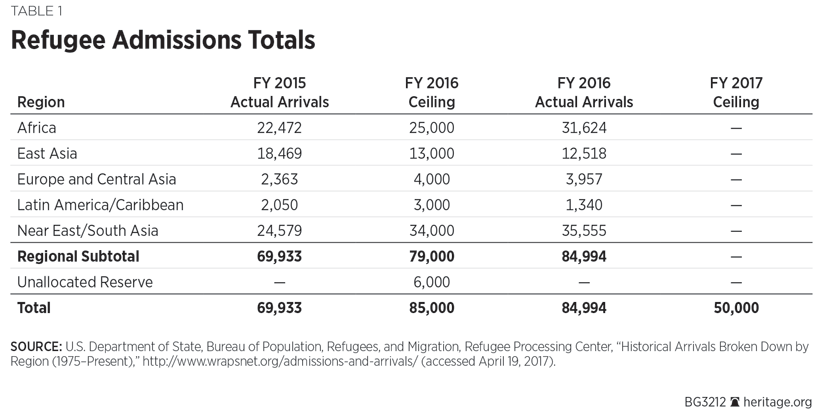
USRAP classifies refugees into three priority categories:
- “Priority 1 [P-1]: Cases that are identified and referred to the program by the United Nations High Commissioner for Refugees (UNHCR), a United States Embassy, or a designated non-governmental organization (NGO).
- “Priority 2 [P-2]: Groups of special humanitarian concern identified by the U.S. refugee program.
- “Priority 3 [P-3]: Family reunification cases (spouses, unmarried children under 21, and parents of persons lawfully admitted to the United States as refugees or asylees or permanent residents (green card holders) or U.S. citizens who previously had refugee or asylum status).”[REF]
Once a referring agency refers a case from one of these categories to USRAP, Resettlement Support Centers (RSCs) run by aid organizations and funded by the State Department conduct a series of interviews with the applicants. The interviewers collect applicants’ biographic information and their story of why they fled their country and why they cannot return. RSC staff also initiate biographic security checks that scan databases maintained by the Departments of State, Homeland Security, Defense (DOD), the Drug Enforcement Administration, the Federal Bureau of Investigation (FBI), the National Counterterrorism Center, and Interpol.[REF]
In addition, the FBI and intelligence community completes a Security Advisory Opinion (SAO) on refugee applicants whom the U.S. considers higher risk due to being a member of a specific group or nationality. The intelligence community must complete the SAOs before the USCIS can approve a refugee application. Similarly, the RSC initiates interagency checks (IACs) that several U.S. intelligence agencies conduct over the course of the refugee-vetting and interview process. IACs use biographic data including names, dates of birth, and other data points to compare against intelligence within the intelligence community.
For populations of greater security concern, as is currently the case with Syrians, the U.S. applies additional scrutiny.[REF] Under the Syrian Enhanced Review Process, DHS officials review case files, use intelligence to identify potential threat indicators, and provide research and specific questions for USCIS adjudicators to use during the interview process. The USCIS then reviews and employs the SAOs, IACs, and research from the enhanced review in their adjudication process, as well as performs biometric checks of DOD, FBI, and DHS databases.
With this information on hand, USCIS officers conduct a final interview to determine whether to accept the applicants for resettlement to the United States. All USCIS refugee officers, as well as asylum officers who sometimes travel overseas to augment the screening efforts, are trained to test applicant stories for consistency with information they gave in previous interviews and against details of the conflict the applicants fled.[REF] Officers also receive additional training on country-specific issues.[REF] Those who interview Syrians, for instance, undergo a one-week training on Syria, including classified briefings.[REF]
An applicant approved by the USCIS then undergoes medical screening. Upon completion, and after clearing all of the security checks, he will fly to the U.S. It generally takes between 18 months and 24 months from initial referral by the UNHCR to entering the U.S. In the waning months of the Obama Administration, however, the U.S. reduced the time to as little as three months for Syrians[REF] by surging resources to the region.[REF]
Once the refugee is in the U.S., a Voluntary Agency (VOLAG)—a domestic, often faith-based NGO of which there are nine nationally—will work with a network of local affiliates to provide him with housing, food, clothes, assistance applying for schools and government programs, and orientations that last between 30 days and 90 days.[REF] VOLAGs receive as much as $1,800 per refugee from the State Department’s PRM to cover these costs.
After the initial resettlement benefits expire, HHS’s Office of Refugee Resettlement (ORR) may help refugees access various forms of assistance, including Temporary Assistance for Needy Families (TANF), Supplemental Security Income (SSI), and Medicaid for those who meet the eligibility requirements. ORR will also reimburse states that provide Refugee Cash Assistance (RCA) or Refugee Medical Assistance (RMA) to needy refugees who do not meet all the eligibility criteria for TANF, SSI, or Medicaid. Receipt of RCA and RMA is limited to eight months, while refugees may receive TANF for five years, and SSI and Medicaid for seven years.[REF]
Refugees are required to obtain a green card granting legal permanent residence within one year of arrival. Upon obtaining a green card, refugees are eligible to access benefits from roughly 90 means-tested government welfare programs according to the same income-eligibility standards applied to U.S. citizens.[REF] The U.S. allows refugees to bypass the usual five-year waiting period required for other immigrants to receive benefits from these programs.[REF]
Refugees also become eligible for Social Security and Medicare after 40 quarters of employment.[REF] Refugee minors are automatically eligible for public education at the state and local level. The average cost of public primary and secondary education in the U.S. is over $12,000 per student per year.
States may also provide refugees with other benefits such as job training, day care, and language education, with ORR reimbursing the costs. In some states, private-sector entities and nonprofits play a large role providing similar assistance through a public-private partnership or through a Matching Grant Program that matches every $1 raised by a VOLAG with $2 in federal grants, up to $2,200 per person.[REF]
Another arrangement is the “Wilson/Fish” option that provides ORR funding to local resettlement organizations or affiliates of the VOLAGs so they can provide benefits in a more effective manner by integrating cash support, medical care, and social services.[REF] ORR also provides grants directly to states and nonprofits to assist in the provision of social services.[REF]
In theory, the government provides various forms of assistance to encourage refugee self-sufficiency. However, the current ORR definition of “self-sufficient” can include refugees who receive federal non-cash assistance as well as significant tax credits, such as the earned-income tax credit and the Additional Child Tax Credit. Self-sufficiency is a laudable goal but one not well measured by existing metrics.[REF]
The cost of the entire refugee program is difficult to estimate because it is spread across different agencies and organizations. However, based on the budgets of the USCIS, PRM, and HHS, USRAP, excluding future welfare and government benefits, likely costs between $1 billion and $1.25 billion in FY 2015.[REF]
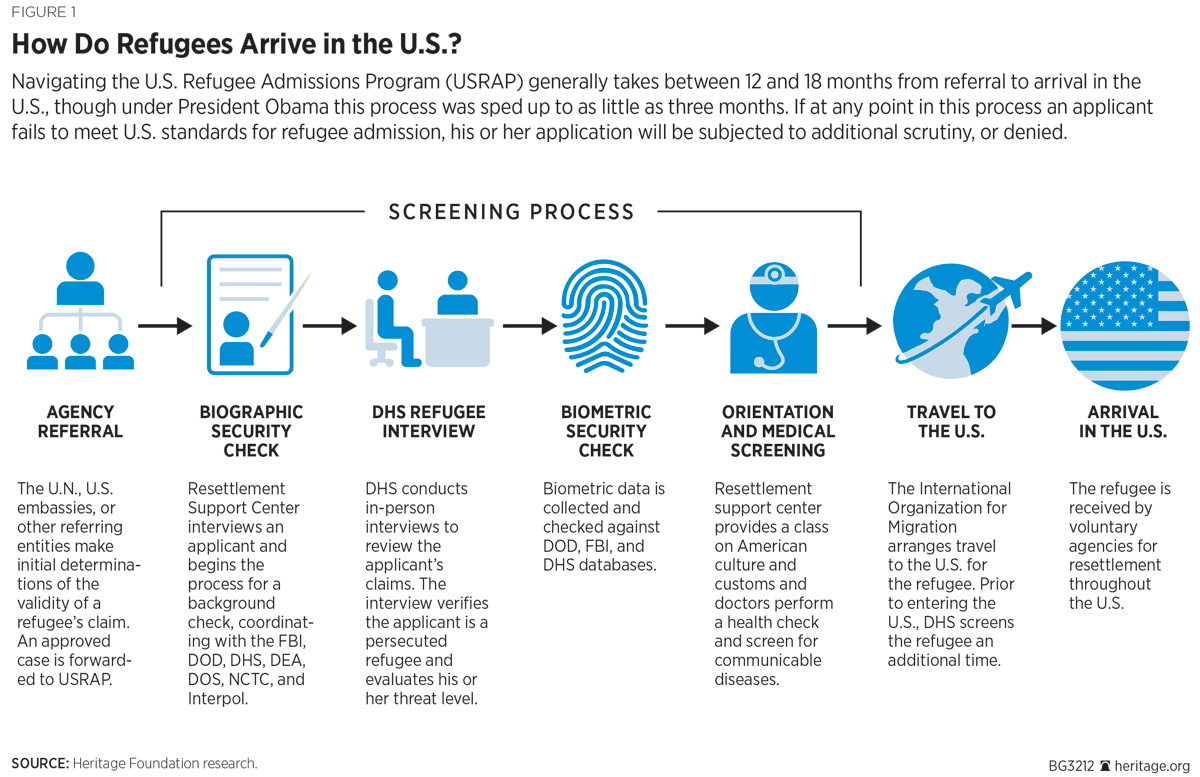
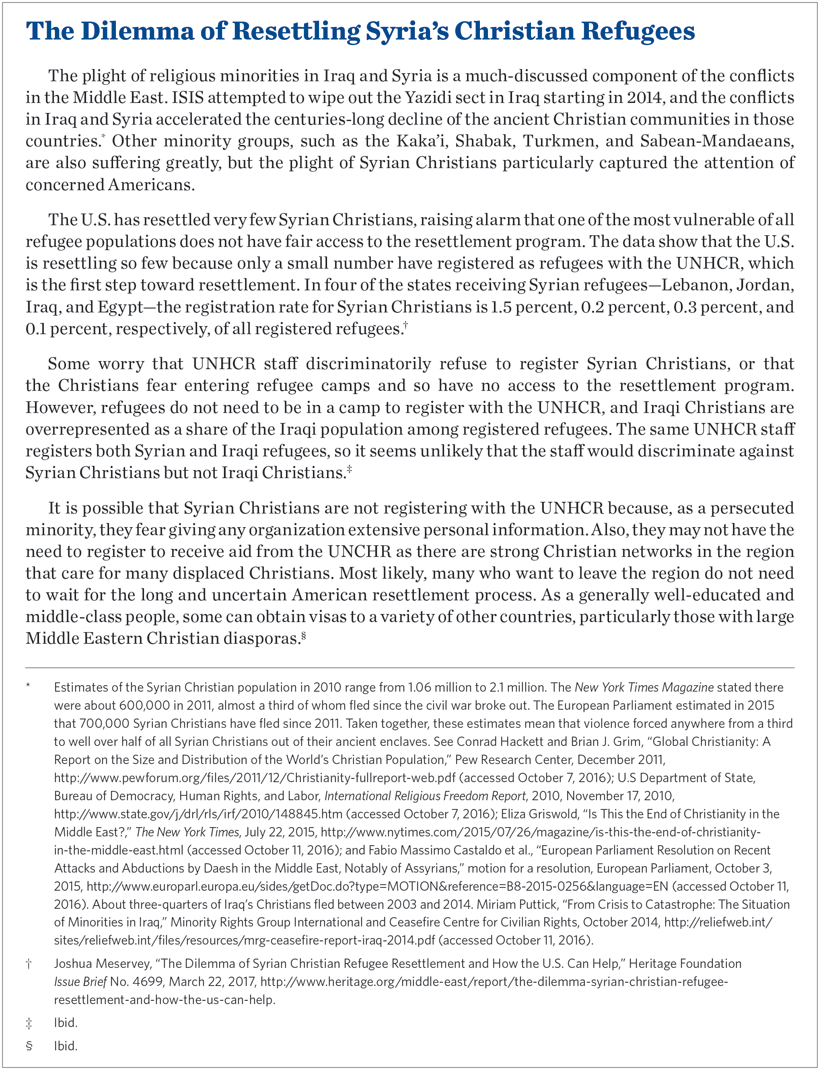
Challenges of U.S. Refugee Resettlement Policy
There are a number of security challenges posed by the U.S. Refugee Admissions Program.
Security Challenges.
The Limitations of the Vetting System. The 9/11 terrorists were not refugees, but after they came to the U.S. legally on business, tourist, or student visas, the United States temporarily suspended the refugee resettlement program and overhauled its system for vetting refugees.[REF] Persons processed for refugee resettlement in the U.S. now undergo more rigorous security checks than any other immigrant group.[REF]
Nonetheless, there are concerns that the next terrorist may come to the U.S. on a refugee visa. According to the National Counterterrorism Center, individuals with ties to Syrian terrorist groups have already attempted to infiltrate the refugee system,[REF] and in the past USRAP resettled several terrorists to the U.S.[REF]
There is no way to design a foolproof vetting system, and the one used for refugees has a number of limitations. The array of security checks run on applicants consists of feeding their biographic and biometric information into security databases to see if they are included on terror watch lists, in criminal databases, or raise other red flags. The obvious limitation is that the security databases do not—and cannot—contain information on every bad actor in the world. The vetting system will only catch someone bent on violence—whether a refugee or any other immigrant—if his information has already been collected and entered into the database.
As senior U.S. government officials acknowledged is the case with Syria, it is even harder to check people from war-torn or adversarial countries.[REF] States wracked by violence are unlikely to have thorough, if any, terrorism and criminal databases. Similarly, refugees fleeing violence are understandably less likely to have documents verifying their identities or flight stories, and people can sometimes easily acquire forged identity documents in unstable countries.[REF]
Other levels of the vetting program have limitations as well. The USCIS trains its officers in interview techniques, yet in many cases officers have little data with which to verify a refugee’s claim beyond checking that the refugee has consistently told the same story throughout the multiple required interviews. Applicants can also sometimes explain away any inconsistencies as translation or clerical errors, leaving the USCIS officer with little to gauge the refugee’s veracity.
Furthermore, many USCIS officers travel throughout the world and interview refugees from a broad range of contexts, making it difficult to develop a deep knowledge of the culture, history, and conflicts of a specific region. Officers receive support from other elements of DHS and the intelligence community, and receive regional briefings ahead of time, but deeper regional experience would help officers determine the authenticity of refugees’ claims.
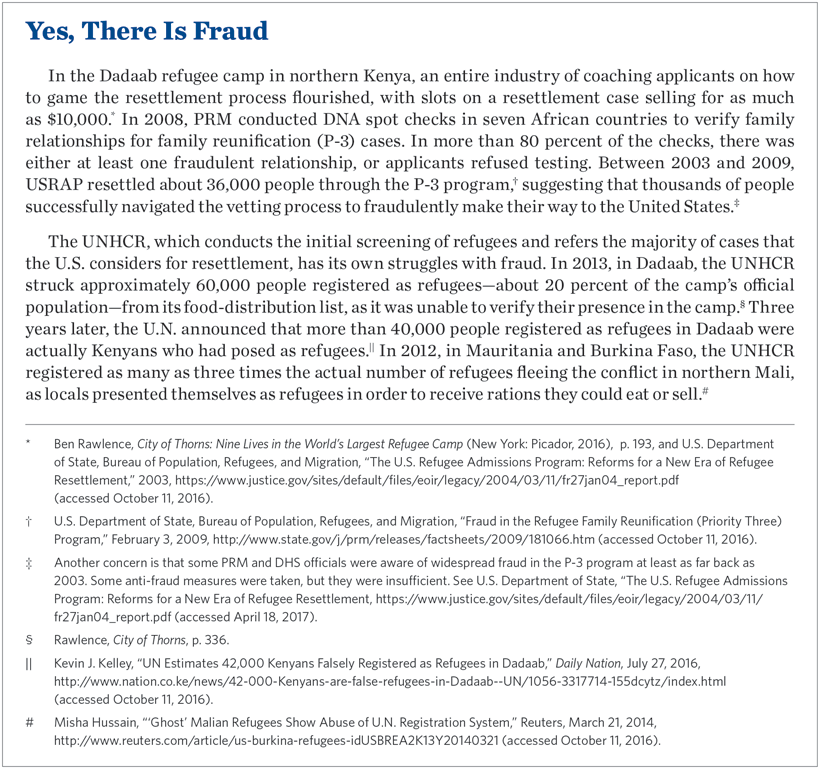
Repeated and widespread fraud within the global refugee system highlights the limitations of the vetting process. The UNHCR now uses biometric data to verify the identities of many of the refugees it registers, which should lessen some forms of fraud. PRM also made reforms after shutting down the P-3 program for four years after it discovered widespread fraud in 2008.[REF] The program has restarted, but now USRAP uses DNA testing to verify most family relationships.[REF] DNA testing is not required for P-1 or P-2 applicants, however.
The Scope of the Security Threat. Figures of how many refugees in the United States have been involved in terror-related activity since September 11, 2001, range from three to 40.[REF] Some of the discrepancy in the numbers is due to various sources defining “refugees” and “acts of terror” differently. In order to analyze the entirety of the threat, this Backgrounder counts anyone who entered the U.S. as a refugee who was credibly implicated in or convicted of Islamist terrorism-related offenses in the United States or overseas.
While incomplete data in open-source reporting makes it impossible to determine the exact number of individuals in this category, The Heritage Foundation counted 61 people who came to the U.S. as refugees who later engaged in Islamist terrorist activities between FY 2002 and FY 2016.[REF] However, many of those entered the U.S. before FY 2002.[REF]
It is noteworthy that most of these individuals do not appear to have entered the U.S. as terrorists, but instead radicalized after their arrival. Five refugees successfully committed a terrorist attack inside the U.S., two of which occurred after the U.S. reformed the program post-9/11.[REF]
To put the security threat in perspective: between FY 2002 and FY 2016, when the 61 refugees engaged in terrorist activity, the U.S. admitted approximately 869,000 refugees, of which about 279,000 were Muslim.[REF] Overall, since the formal start of the current refugee system in 1980,[REF] just under 3 million refugees have entered the United States.[REF] During the same time period, the U.S. gave out over 33 million green cards to legal immigrants[REF] and admitted billions of non-immigrants to the U.S. for temporary stays.[REF] Furthermore, in the past, the majority of resettled refugees have been Christians[REF] and people from non–Middle Eastern countries.
The data that are available show the security challenge posed by refugees falls into three categories: (1) radicalized refugees who slip through the vetting process and commit terrorist offenses; (2) adult refugees who radicalize once in the U.S. and then commit terrorist offenses; and (3) refugees who were resettled at a young age—often known as the “1.5 generation”—or the children of resettled refugees, who radicalize and then commit terrorist offenses. The distinctions among these three groups are important, as they represent different challenges and require different solutions.
The first scenario appears to be the most rare, as there are only a few reports of radical Islamists getting to the United States through the refugee resettlement program.[REF] Similarly, there are a handful of confirmed cases of refugees resettled as adults who radicalized in the United States.[REF]
The most difficult radicalization challenge is with children who are resettled at a young age, or the children of resettled refugees. The experience of the Somali-American community is illustrative of the problem. Seventy-four Somali-Americans or Somali residents of the U.S. have been credibly implicated in terror-related activity since 1997. Incomplete biographic information makes it difficult to determine when most of the 74 radicalized. Nevertheless, there is enough data for 18 of the 74 radicalized individuals to determine that most of the 18 likely radicalized in the United States.[REF]
The young immigration ages and histories of extremist Somali residents of the U.S. is in keeping with the challenge that Europe has experienced with its own 1.5 generation. The 1.5 generation may feel isolated and caught between two worlds, not fully at home either in their parents’ or in their adopted country, which may heighten the appeal of radical messages promising purpose and identity.[REF] This seems to be one of the dynamics driving radicalization in the Moroccan-Belgian community, which produced Abdeslam Salah and Abdelhamid Abaaoud, key players in the Paris terror attacks.[REF] Most of those involved in the recent spate of French terrorism are the children of first-generation immigrants, arrived in France at a young age, or are “native” converts to Islam.[REF]

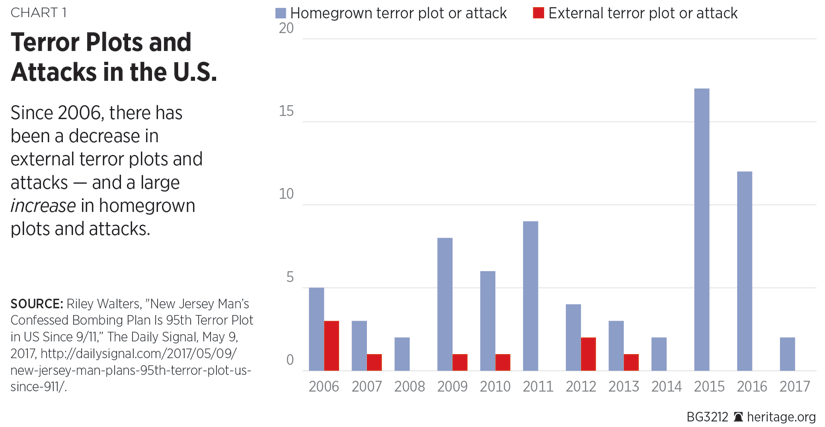
Assimilation Challenges. Assimilation into mainstream culture is key to immigrants’ success. Embracing an American creed, learning English,[REF] and gaining an education help immigrants build an American identity, and the knowledge, skill sets, and social capital that increase their sense of belonging in American society. Non-assimilation, by contrast, can consign immigrant groups to life in isolated enclaves mired in economic underperformance, crime, and higher rates of Islamist radicalization than among the general public.[REF]
Assimilation does not require that refugees forget their heritage—generations of immigrants have added cultural and human capital to the U.S. because of their diverse backgrounds. Assimilation simply asks that immigrants embrace the values of the United States, and develop loyalty to the U.S. and fellow Americans above other countries and people—finding “the correct balance between keeping their traditions and adopting America’s virtues, between pride in their ancestry and love of their new country.”[REF]
There is no reason to assume that the children of immigrants will automatically assimilate. Children will inevitably adopt some of the forms of American culture, but it is not a given that they will develop a superseding loyalty to all fellow Americans, the United States, and its values. For this reason, it is critical that the U.S. have a coherent assimilation strategy.
Values Differences. One of the challenges of resettling refugees is that some hold values that are at odds with cherished American tenets. In the past, the United States met this difficulty by officially encouraging assimilation. Absent a return to that policy, assimilating refugees will be difficult.
The contexts in Middle East and North African (MENA) countries highlight such challenges. A December 2015 Pew poll of Muslims in seven MENA countries found that the average across the countries of those who supported making sharia (Islamic) law the official law in their country was 70 percent.[REF] A 2013 poll found that among those polled in MENA countries who support sharia, a median of 59 percent believed that anyone who leaves Islam should be executed.[REF]
The 2013 poll also found alarming levels of support for treating women in ways anathema to Americans.[REF]
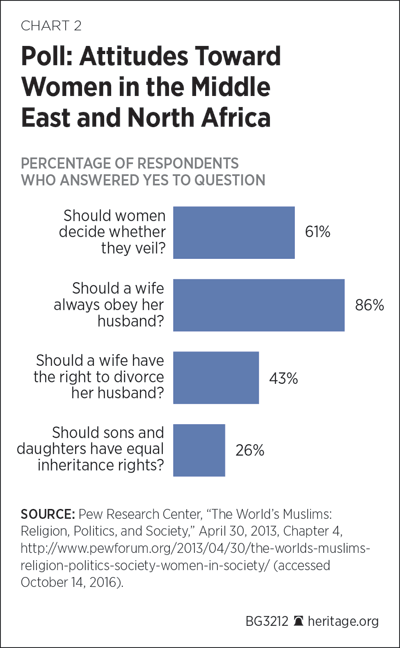
A small percentage of people in the MENA region harbor sympathy for violent Islamist groups as well. A poll by the Arab Center for Research and Policy Studies found that an average of 11 percent of respondents in six MENA countries, in the Palestinian territories, and among Syrian refugees had a “positive” or “positive to some extent” opinion of ISIS.[REF]
Education and Skill Levels. An education and skill mismatch with advanced economies exacerbates the assimilation challenge. Europe’s struggle to assimilate its Muslim community is a prime example. Many European Muslims arrived on the continent as low-skilled labor to help rebuild Europe after World War II.[REF] Generations later, European Muslims still have higher poverty[REF] and lower education rates than non-Muslim Europeans.[REF]
By contrast, many American Muslims immigrated here to further their education and then stayed on,[REF] equipping them to thrive economically and socially in the United States. American Muslims are, by most metrics, better assimilated than their European counterparts.[REF]
The United States has not been free of European-style assimilation problems, however. Many Somali-Americans arrived in the United States as refugees with pronounced educational and skill-set disadvantages. Of those born overseas, many spent years as refugees with few opportunities to work and gain an education. Their home country is wracked by two decades plus of instability, with widespread illiteracy, an underdeveloped, mostly informal economy, and a complex clan system that serves as the primary method of social organization. In other words, Somalis arrived to the U.S. poor in social, human, and financial capital.
Unsurprisingly, the community has struggled to adjust to life in the United States. Foreign-born Somalis rank last in English proficiency, median annual earnings, and employment rates of all African immigrants to the United States, and have some of the lowest rates of educational achievement.[REF]
Refugees from other sustained conflicts are likely to have similar challenges. Rates of educational achievement among Syrians, for instance, are significantly lower than in the United States, and the instability gripping their country has for years interrupted many Syrian children’s schooling.[REF] Of the Syrian refugees who arrived to the U.S. in FY 2011–2016 who were 21 years or older, 41 percent had a high school degree. Sixteen percent of those 21 years or older had a professional, technical, or university/college degree.[REF]
These numbers are consistent with the Swedish Migration Agency’s findings that half of recent Syrian asylum seekers in Sweden lack a high school education, and one-third never made it beyond ninth grade.[REF] By comparison, 33 percent of Americans had a bachelor’s or higher degree in 2015, and 88 percent had at least completed high school or obtained a GED.[REF]
Facing the Challenges
Enhancing Security. The security challenge associated with USRAP is limited. Nonetheless, a successful refugee program will be honest about the security risks and make sure to mitigate them. Helping USCIS officers to build greater expertise in the regions in which they operate, increasing counter-fraud measures, revamping the U.S.’s outdated or aging immigration benefit management and screening systems, and other reforms can further lower the risk of terrorism due to USRAP.
The U.S. government has already taken precautions to improve refugee screening in particularly worrisome conflict zones, such as through the Syrian Enhanced Review process. While not foolproof, the review demonstrates that the U.S. government recognized the risks associated with screening refugees from war-torn areas, and made modifications accordingly. The U.S. should continue to review and modify the process as needed to ensure its future effectiveness.
The U.S., however, must also recognize that security vetting on the front-end of the refugee process does not eliminate risks from homegrown radicalization of refugees in later generations. The most important component of a strategy to mitigate such risks should be a comprehensive plan for assimilating refugees.
Assimilation in America. Assimilation is inherently difficult to measure, but employment and educational attainment can be useful, albeit incomplete, indicators of assimilation. A further look at cultural values also assists in evaluating the successes of refugee assimilation in the U.S.
Though education levels vary by country of origin, refugee education levels are generally higher than those of immigrants to the U.S., and lower than for the U.S. native population.[REF] Some of the struggles that refugees experience, such as learning English, could be overcome through improvements in education and greater civil society involvement.
Employment rates for refugees are encouraging, but vary among different groups. The Migration Policy Institute’s study of refugees from the top ten sending countries found that 67 percent of refugee men are employed as opposed to only 60 percent of U.S.-born men.[REF] Employment for refugee women and native-born women are comparable to each other and above 50 percent.[REF] A closer look at refugee data, however, reveals that some groups perform better than others.[REF] For example, Burmese, Iraqi, and Somali refugee men were employed at or below the rate of U.S.-born male workers.[REF] Cuban, Iranian, Burmese, Somali, Bhutanese, and Iraqi women fell below the average rate of employment for native-born women.[REF] Varying employment rates may be affected by discrepancies in English proficiency and native-language literacy. According to the same report, refugees’ median household income between 2009 and 2011 was $42,000, which falls below the median household income for both immigrants and U.S. born workers.[REF]
It is difficult to gauge true assimilation, but the U.S. has certain advantages that will likely help the process. Overall, refugees in the U.S. have far better employment outcomes than refugees in Europe, for example.[REF] Moreover, the American Muslim population is generally diverse and spread throughout the country, which makes it more difficult, though not impossible, for ethnic and religious enclaves that inhibit assimilation—as is the case in Europe—to develop.[REF] Additionally, the United States has a history of assimilating immigrants with strong cultural and religious differences, and Middle Eastern refugees will be joining existing Muslim communities in the United States that are relatively well assimilated: American Muslims today are as well-educated and well-off as the average non-Muslim American.[REF]
American Muslims are also likelier to reject un-American values at higher rates than their co-religionists in many parts of the world. In a Pew Research poll, 81 percent of American Muslims said that suicide bombing or other violence against civilians is never justified (with 1 percent saying that it is often justified), while the global average is 67 percent. Five percent of Muslims born in the U.S. have a favorable view of al-Qaeda, with 2 percent of Muslim immigrants holding such a view, while the global average is 14 percent.[REF] In a different poll, 89 percent of U.S. Muslims—a higher rate than other religious groups or the general public—believed individuals or small groups are never justified targeting and killing civilians.[REF] While even one American with a favorable view of terrorism is one too many, American Muslims’ greater acceptance of Western values is a likely indicator of assimilation.
Encouraging Economic Success. USRAP is a humanitarian program only, and is not designed to spur U.S. economic growth. However, evaluating the fiscal and economic effects of refugees is critical to ensuring that USRAP is facilitating their economic success as much as possible, and to providing policymakers with the data to understand the full costs and benefits of the program.
Determining the fiscal impact of refugees, or any immigrants, requires considering a number of variables.[REF] The most relevant are the ages and education levels of the refugees, the generosity of benefits made available to them, and employment opportunities.
On average, younger, more educated immigrants who move to a country with less-costly government benefits and plentiful employment opportunities are more likely to be a net fiscal positive. However, older, less-educated, or less-skilled immigrants who move to a country with generous government benefits and fewer employment opportunities are more likely to be a net drain on fiscal resources.[REF] Given that refugee resettlement is generally for the most vulnerable and for those from countries suffering disruptive wars, refugees often have lower levels of education or skill, or have difficulty translating their skills into advanced economies.
An International Monetary Fund study of refugees to Europe, which tends to provide more government benefits and has relatively high unemployment, found that for as many as 20 years, refugees tend to be less employed and more dependent on social benefits than native workers or other immigrants groups.[REF] A study of refugees to Australia found similar long-term fiscal costs.[REF] Another study found that in 2015, Sweden redistributed 1.35 percent of its gross domestic product (GDP) to refugees accepted into Sweden, though other European countries would face smaller costs due to their smaller per capita refugee populations.[REF] The academic literature generally finds that refugees consume more in government benefits than they pay in taxes.[REF]
Refugees sheltering in the Middle East have achieved some economic successes. Syrian refugees, for example, are starting businesses and contributing to Middle Eastern economies through consumer purchases. One study conducted by the World Bank estimated that Syrians owned 26 percent of newly registered businesses in Turkey.[REF] Consumer spending, partially driven by refugee expenditures, had a positive effect on the Lebanese economy in 2015, as one study estimated that Lebanon’s real GDP grew by 2.5 percent.[REF] Not all economic indicators for refugees are positive,[REF] but USRAP is worth continuing not because it is an economic boon to the U.S.—it is not—but because it advances U.S. national interests in other ways.
The U.S. has ways of minimizing the fiscal costs of refugees and improving their economic outcomes, particularly by better leveraging the resources and unique capabilities of the U.S. private sector, nonprofits, and individual citizens. The Matching Grant Program is one such example. It requires refugees to prove that they have received a job within six months of arrival. In 2015, the program helped 82 percent of refugees attain “self-sufficiency” (an imperfect metric as defined by ORR and explained earlier in this Backgrounder) in the first 180 days of being in the U.S.[REF] Furthermore, close to 70 percent of refugees enrolled in Matching Grant programming had employment by the end of 180 days.[REF] The Matching Grant Program has enjoyed greater success than other traditional government-funded refugee programs by leveraging private-sector resources.[REF]
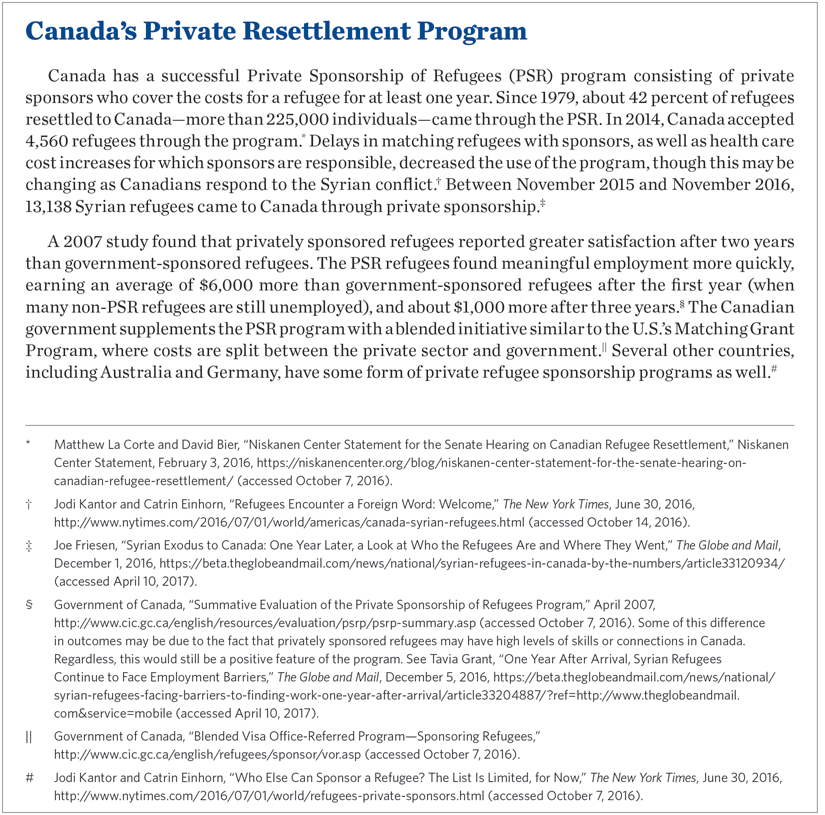
In America’s Interest
The U.S. government should enact refugee policies that advance the country’s interests. To do so, the U.S. should:
- Focus U.S. resources on ameliorating the plight of refugees in front-line states. The U.S. should stretch its finite resources as far as possible by focusing on improving refugee welfare where refugees are sheltering. Rallying the international community to meet funding shortfalls for organizations working with Middle Eastern refugees, and encouraging host countries to enact refugee-friendly economic policies, would help.
- Build a comprehensive assimilation strategy. Refugee assimilation is critical to USRAP remaining in U.S. interests. Policymakers should require PRM to create an assimilation strategy that all stakeholders should implement throughout and after the resettlement process. Additional stakeholders include ORR, civil society organizations—including VOLAGs—and the public school system that should emphasize civics education. The strategy should include measurable benchmarks of success, such as English-language acquisition, and require regular progress reports from the implementing agencies.
- Mobilize civil society to enhance refugee assimilation. Places of worship, community groups, academic communities, and similar groups can marshal extra resources for refugees and facilitate their entry into mainstream society. Doing so is critical for building social capital[REF] and developing civic pride and patriotic attachment to other Americans. The U.S. can mobilize civil society groups through targeted grants, and should give priority to groups with a track record of fostering assimilation.
- Avoid further categorizing, or dividing, Americans. The Obama Administration called for the addition of a new racial minority category—a MENA classification. Such classifications further divide people along ethnic lines and could create opportunities for government to exploit minority groups.[REF] The U.S. should resist creating new divisions in its refugee and other immigrant programs, and instead rely on patriotic assimilation programs to improve assimilation outcomes.
- Enhance the Matching Grant Program and other ORR public-private partnership programs. Increased private funding could expand programs, such as the Matching Grant Program or microenterprise grants, that support private-sector solutions to refugee assimilation. Congress should provide more funding with which to match private giving. The U.S. should also shift funding to other programs that collaborate with the private sector and drive economic performance among the refugee population.
- Pilot private resettlement programs. Refugees resettled to Canada through its private resettlement program have better assimilation outcomes, and report greater satisfaction with their new lives, than those resettled by the government alone.[REF] Private money would also free up government money to help more refugees in the U.S. or abroad. Congress should amend existing refugee law to establish private resettlement pilot programs. Congress should set the number of refugees it will allow to participate in these pilots, and that quantity should count toward the yearly admissions ceiling. It is difficult for private sponsors to support a refugee with significant health issues, so the U.S. should design the program to ensure that private sponsors do not shoulder the burden of onerous medical costs.
- Specifically support highly educated and highly skilled refugees. Some refugees will be highly educated and skilled. The U.S. should convene representatives of groups involved in credentialing and granting academic credit in the U.S., and encourage them to create a process for assessing degrees and credentials earned overseas; recognizing the level of educational attainment and technical qualification with the appropriate U.S. credential; and assisting refugees in preparing for licensing and certification tests.[REF] The U.S. should also cut all but the critical credentialing requirements for various professions, making it easier for refugees and citizens alike with relevant skills to break into the industry. Doing so will quickly bring productive workers into the U.S. labor force, and enhance their prospects for assimilation.
- Urge Middle Eastern countries to resettle Syrian and Iraqi refugees. Many Syrian and Iraqi refugees share similar cultural and religious values with the people of the Gulf States, which have the financial capacity for resettlement. The Gulf States are not signatories to the U.N. Refugee Protocol and do not offer refugee status, and thus far have not resettled any Syrian or Iraqi refugees. Instead, several of them have admitted—primarily as migrant workers or to reunify families—an unknown number of Syrians.[REF] Saudi Arabia, Qatar, and the United Arab Emirates have donated hundreds of millions of dollars each for relief efforts to the Middle Eastern refugee crisis,[REF] but the U.S. should urge the Gulf States to increase their aid for their Arab Muslim neighbors by resettling Syrians with all the rights and protections due to refugees.
- Grant victims of ISIS genocide P-2 status under USRAP. P-2 refugees are “groups of special humanitarian concern identified by the U.S. refugee program.”[REF] The U.S. considers Yazidis, Shi’a Muslims, and Christians victims of attempted genocide, and so should grant them P-2 status as a reflection of their special vulnerability.[REF]
- Focus on developing a person-centric vetting system. Many of the U.S. security, vetting, and case management systems are outdated. From the USCIS’s primarily paper-based immigration benefits system to the effective but aging TECS system, the U.S. is working to update its systems, with mixed success. The next generation of vetting and case management system should allow the user to retrieve quickly all the records available on a given person, a so-called person-centric vetting system. DHS is already investigating the use of person-centric systems[REF] and Congress should support this effort to enhance vetting measures.
- Focus on best candidates for resettlement. As there are so many applicants, the U.S. should emphasize applicants’ credibility as a resettlement criterion. By doing so, the U.S. can continue to help those in need while lessening the security and fraud risks. The USCIS should also ask refugees whether they plan to adhere to the laws and Constitution of the United States, and give specific examples of what sort of laws and rights all residents and citizens of the U.S. are required to respect. Doing so would emphasize to the refugees the importance of embracing and respecting the fundamental rights and values of the U.S. It would also give immigration officials clearer grounds on which to arrest or deport any who later violate U.S. laws.
- Avoid speeding up the resettlement process except in extreme cases. The security risks associated with resettlement remain low mostly because of the long duration of the process and the relatively slim chance that USRAP will select any one person for resettlement. Corruption and fraud, however, can undermine these natural protections. Except in extreme circumstances, such as a medical emergency, USRAP should not rush refugees through the vetting and resettlement process.
- Only resettle refugees from front-line states, with rare exceptions. The refugee admissions program is only for truly vulnerable refugees. If a person passes through a front-line state that offers an acceptable level of security in search of a better economic situation, he more closely fits the definition of an economic migrant rather than a refugee.
- Only resettle refugees who match the vulnerability criteria. Many refugees live in protracted refugee situations, but a long, or even indefinite, stay in a host country is not reason enough for resettlement. The refugee should be in imminent danger inside the host country in order for USRAP to consider him for resettlement.
- Require regions of focus and reward relevant language skills for USCIS officers. Requiring USCIS officers to specialize in a region throughout their careers, rather than moving among various regions with profoundly different conflicts, histories, and languages, will help them better fulfill their duties. Congress should also reward adjudicators who are proficient in a major language in their region of focus. Interpreters facilitate the refugee interviews, but speaking directly with the applicants or monitoring the translation will allow officers to better assess applicants’ credibility.
- Require the USCIS to conduct regular comprehensive fraud assessments. Fraud is a known problem within the U.S. immigration system, and the complexity and rapidly evolving nature of many refugee crises pose a particular challenge. Despite this, the USCIS has not released any large-scale fraud assessment reports since 2009 on any immigration programs.[REF] The USCIS should revitalize its efforts to study immigration fraud to understand better the challenge and how to combat it, thereby protecting the integrity of the program.
- Increase the use of DNA spot checks to detect and deter fraud. DNA checks are now required for most P-3 applicants but not for other categories of refugees. The USCIS should conduct random DNA spot checks on a certain percentage of P-1 and P-2 cases to verify family relationships and deter applicants from claiming non-relatives as next of kin. The USCIS can make exceptions for extenuating circumstances, such as those explicated in UNHCR guidelines.[REF]
- Encourage the UNHCR to increase its fraud-prevention activities. Fraud committed against the UNHCR by refugees, or those posing as such, can bleed into USRAP. Anti-fraud measures should include merging the various ProGres databases—in which the UNHCR stores the information it collects from refugees—that each UNHCR office currently operates independently. Doing so would allow UNHCR staff to crosscheck refugee information with other offices quickly. The U.S. should also encourage the UNHCR to increase the use of iris scans, which it already uses to verify refugees’ identities in some locations, to all areas of its operation.
- Reform USCIS appropriations. The fees that the USCIS levies on immigrants for legal immigration services currently provide almost all of its funding. Direct appropriation should provide for other functions of the USCIS, such as management, fraud prevention, and refugee and asylum operations, rather than being tied to funding from immigrants. That would ensure that the U.S. always funds these activities regardless of other factors, and would allow Congress to exercise greater oversight and provide greater input on the operations of the USCIS.
- Reject attempts to link refugee rights to a global right to migration. It is possible that some will attempt to use the issue of refugee resettlement to advocate for a global right to migration. The U.S. must resist such attempts.
- Undertake long-term studies of refugee performance and well-being. ORR does not track resettled refugee outcomes over the long term. To determine how best to assist resettled refugees in becoming truly self-sufficient, and whether the program remains in the best interests of the United States and the refugees, the U.S. should track outcomes long after ORR assistance ends.
- Affirm the role of Congress in setting refugee-admission levels. Congress should allow the executive branch to select the number of refugees between a ceiling and a floor based on historical refugee levels. For example, over the past 20 years, the 20th percentile of refugee admissions was 50,577 refugees and the 80th percentile was 73,982. Other time frames, such as 10 years, 15 years, or 25 years, would also be appropriate, and Congress could base the ceiling and floor on another percentile range such as the 15th to the 85th, or the 25th to the 75th. If the President chose a refugee-admission level outside this band, he would need approval from Congress. Such a process would ensure that Congress is involved in any dramatic changes in refugee levels while giving the President the authority to adjust refugee admission within reasonable historical levels.
Securing the Beacon of Freedom
The U.S. Refugee Admissions Program saves the lives of thousands of people every year. This is admirable. At the same time, the U.S. must consider how such generosity affects its national interests. Should USRAP stop being a net positive for the U.S., policymakers should stop it. Despite the challenges detailed in this Backgrounder, USRAP does currently contribute to a stronger U.S. Nonetheless, policymakers can make it a greater benefit to the U.S. and the refugees it helps with smart reforms.
—Olivia Enos is a Policy Analyst in the Asian Studies Center, of the Kathryn and Shelby Cullom Davis Institute for National Security and Foreign Policy, at The Heritage Foundation. David Inserra is Policy Analyst for Homeland Security and Cyber Policy, in the Douglas and Sarah Allison Center for Foreign Policy, of the Davis Institute. Joshua Meservey is Senior Policy Analyst for Africa and the Middle East, in the Allison Center.



